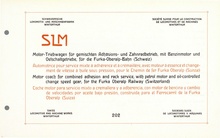FO BCm 2/2
| FO BCm 2/2 | |
|---|---|
| Numbering: | 21, 22 |
| Number: | 2 |
| Manufacturer: |
SLM (drive) SIG (box) Scintilla (el. Equipment) |
| Year of construction (s): | 1927 |
| Retirement: | from 1957 |
| Axis formula : | AA |
| Gauge : | 1000 mm ( meter gauge ) |
| Length over buffers: | 11075 mm |
| Empty mass: | 16.7 t |
| Service mass: | 19.5 t |
| Top speed: | 43 km / h / 20 km / h |
| Hourly output : | 110 kW |
| Driving wheel diameter: | 795 mm |
| Gear system : | Abbot, two-lamellar |
| Number of traction motors: | 1 (8 cylinders) |
| Drive: | petrol |
| Seats: | 8 (2nd class) 24 (3rd class) |
| Classes : | 2 |
The BCm 2/2 series of the former Furka-Oberalp-Bahn (FO) consists of two narrow-gauge railcars with a gasoline engine and a combined, firmly coupled adhesion and gear drive .
history
Shortly after the start of continuous operation in 1925, the FO was looking for a more cost-effective way of doing without the labor-intensive use of trains with the HG 3/4 steam locomotives in times of low traffic . In 1927, the company therefore ordered two two-axle railcars, the boxes of which were built by the Swiss Industrial Company (SIG) in Neuhausen, especially for winter use on the routes in Goms (Brig-Oberwald) and in Tujetsch (Disentis-Sedrun) . The chassis and engines were manufactured by the Swiss Lokomotiv- und Maschinenfabrik (SLM) in Winterthur, which also completed the vehicles. Deviating from the labeling as BCm 2/2, the railcars were listed in the statistics of the Federal Railway Department as BCZm 2/2.
In order to meet the requirements for service in the off-season, the vehicles were given a second and third class passenger compartment , a toilet, a mail compartment and two driver's cabs, one of which could be used as a luggage compartment. In 1934 the second-class compartments were converted into luggage compartments with outside doors, and at the same time they were renamed CFm 2/2.
The construction was not a success, as the vehicles were very weak for operation and also prone to failure, which earned them the nickname of annoyance dressers. With a maximum of one two-axle wagon, they could only carry a very low trailer load with a maximum train mass of 30 t, which increased the travel time between Disentis and Sedrun up to three times.
Nevertheless, it must be taken into account that the railcars played a certain pioneering role, as there was little empirical data available for the construction of the gasoline engines and transmissions at the time and no lengthy preliminary tests were carried out.
technology
The railcars, which were just over 11 m long, had a wheelbase of 4,600 mm. The eight-cylinder boxer engine from SLM achieved an output of 110 kW at 1,200 revolutions per minute. A four-stage oil gearbox was installed as the gearbox , which resulted in speeds of 8.5 / 14/26 and 43 km / h at maximum engine power. A downstream reversing gear operated via dog clutches acted on the two axle drives via a cardan shaft. One axis contained a double gear ratio with a permanently coupled gear and adhesion drive, while the other axis only had an adhesion drive. This axle also contained a loosely mounted, additional brake gear.
Whereabouts
After the electrification of the FO in the years 1941 to 1942, the gasoline railcars were replaced by the significantly more powerful BCFhe 2/4 railcars and lost their importance for passenger transport.
Railcar 21 was still used as a service vehicle from 1941 and was redesignated internally as Xm 2/2 4969 shortly before it was retired in 1957. The vehicle, which had been parked for many years, was given to the collection of the Swiss Museum of Transport (VHS) in 1965 and stored in Hergiswil / Alpnach. In 1973 it was externally refurbished in the Brünigbahn's Meiringen SBB depot and then exhibited in the Verkehrshaus from 1974. In 1996, the Furka Mountain Line Steam Railway (DFB) received the railcar as a loan, which was then awarded for four years in Goldau. He then came to the Aarau car workshop of the Furka Mountain Route Association , where the box and chassis were stored separately. In 2008 it was transported to the new wagon workshop, the two parts were assembled and the weathered exterior paintwork was repaired. The DFB is considering taking over the vehicle from the VHS and converting it to a diesel drive without changing the exterior.
Railcar 22 was sold to the Rhaetian Railway in 1947. The gear drive was removed there and the vehicle was used as the CFm 2/2 150 for late-night courses in Prättigau. In 1956 it was renamed BFm 2/2 150, in 1959 the car was scrapped and the chassis was broken off. The car body was used as a scout bar in Domat-Ems from 1960 until it was finally demolished around 1976.
Sources and literature
- Walter Hefti: The world's rack railways . Birkhäuser, 1971, ISBN 3-7643-0550-9 , p. 142, 320 .
- Werner Heuberger, Hansrudolf Schwabe, Rudolf Werder: FO - Brig – Furka – Disentis . Pharos, 1981, ISBN 3-7230-0312-5 , pp. 76-77 .
- Wolfgang Finke, Hans Schweers: The vehicles of the Furka-Oberalp-Bahn 1913-1999 . Brig-Furka-Disentis. Schöllenenbahn. Furka-Oberalp Railway. Schweers + Wall, Aachen 1999, ISBN 978-3-89494-111-6 , pp. 18-19 .
- H. Wisman, Documentation on the exhibits, E16, January 1975, Swiss Museum of Transport, Lucerne


